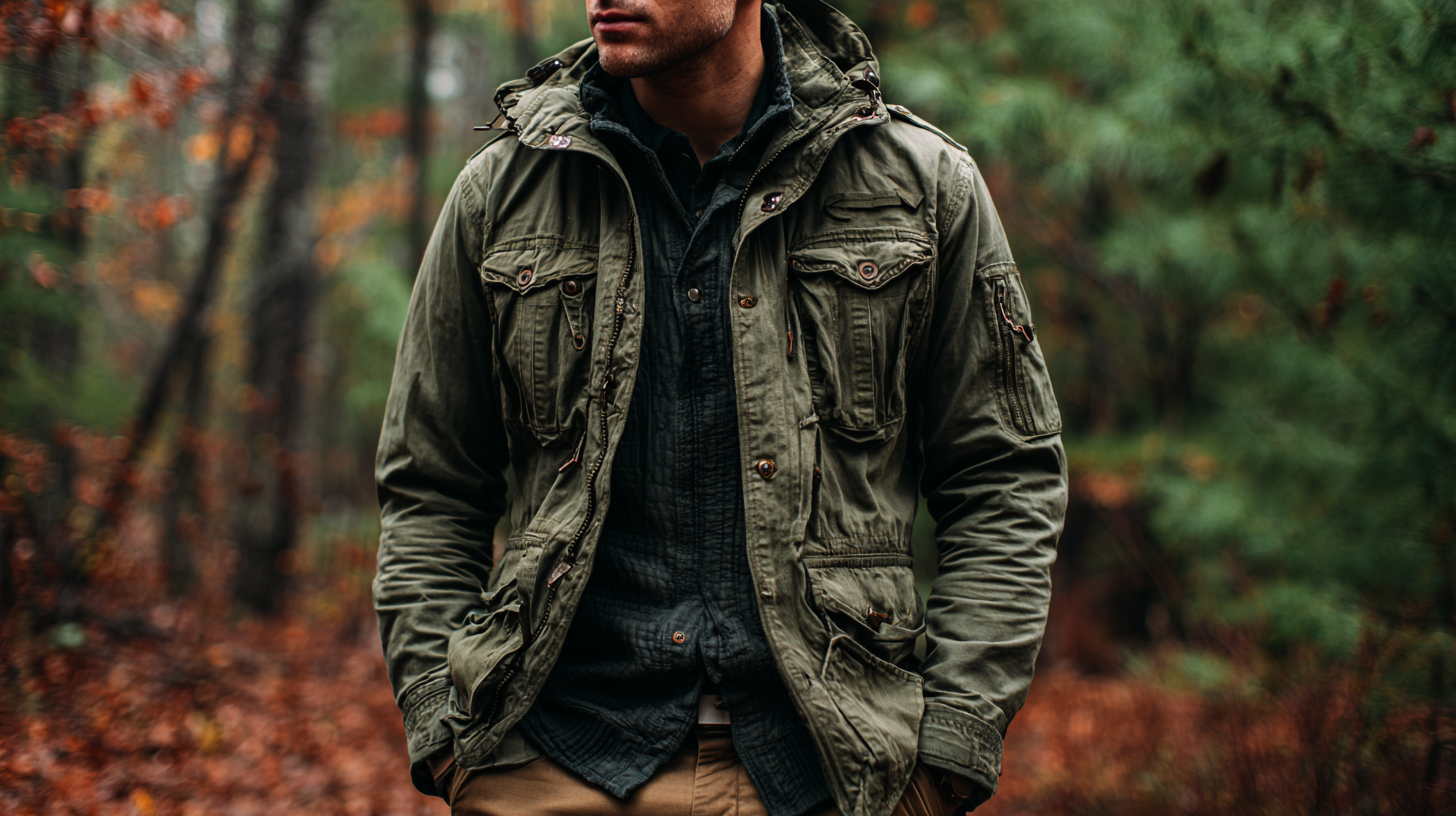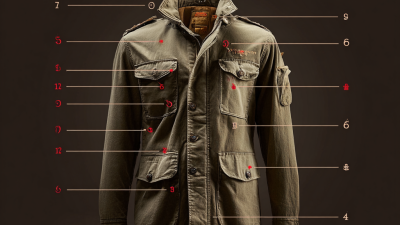In recent years, the field jacket has solidified its place as a versatile staple in modern wardrobes, transcending its military origins to become a fashionable and functional choice for a variety of seasons. According to a report by Grand View Research, the global outerwear market size is projected to reach USD 207.8 billion by 2025, with field jackets emerging as a popular segment among outdoor enthusiasts and urban dwellers alike.
 As individuals seek garments that offer both practicality and style, the appeal of the field jacket continues to grow, especially as brands innovate with materials and designs that adapt to changing weather conditions. Understanding the characteristics, features, and seasonal appropriateness of various field jackets is crucial for consumers aiming to make informed purchasing decisions that balance performance and aesthetics.
This guide will navigate through the essential considerations for selecting the best field jacket for every season, ensuring you remain prepared and stylish year-round.
As individuals seek garments that offer both practicality and style, the appeal of the field jacket continues to grow, especially as brands innovate with materials and designs that adapt to changing weather conditions. Understanding the characteristics, features, and seasonal appropriateness of various field jackets is crucial for consumers aiming to make informed purchasing decisions that balance performance and aesthetics.
This guide will navigate through the essential considerations for selecting the best field jacket for every season, ensuring you remain prepared and stylish year-round.
Field jackets have become essential wardrobe staples, offering versatility and functionality across various seasons. Originating from military use, these jackets are designed to provide both protection and utility. Research shows that in the global outerwear market, field jackets are expected to grow by 6.5% annually, reflecting their increasing popularity among outdoor enthusiasts and urban dwellers alike. Their structured yet comfortable design allows for layering, making them suitable for both warm and cold weather.
In warmer months, lightweight field jackets made from breathable, moisture-wicking materials can offer sun protection while still allowing for airflow. A study from the Outdoor Industry Association reveals that 69% of consumers prioritize moisture management in their outdoor apparel, highlighting the demand for functionality even in summer gear. Conversely, during the winter, insulated versions with added technical features, such as waterproofing and wind resistance, cater to those seeking warmth without sacrificing mobility. These adaptations make field jackets a year-round choice for those who appreciate both style and performance in their outerwear.
When selecting a field jacket for any season, the fabric choice is paramount to ensuring both comfort and performance. Materials such as cotton, polyester, and nylon each have unique properties that affect how a jacket functions in various weather conditions. Cotton, for example, is breathable and soft, making it ideal for milder climates. However, it lacks water resistance and can become heavy when wet, which is a crucial consideration for rainy seasons.
On the other hand, synthetic fabrics like nylon and polyester offer significant advantages in durability and moisture-wicking capabilities. These materials tend to dry quickly, providing a practical solution for unexpected weather changes. Additionally, many field jackets now feature advanced fabric technologies, such as DWR (Durable Water Repellent) treatments, which enhance water resistance without sacrificing breathability. Ultimately, understanding how different fabrics behave can dramatically impact your experience in the field, guiding you to make the best choice for your needs throughout the year.

When it comes to dressing for temperature variations, layering strategies are crucial for maintaining comfort and style, especially with field jackets. According to a report by the Outdoor Industry Association, over 60% of outdoor enthusiasts prioritize versatility in their clothing to adapt to changing weather conditions. A well-chosen field jacket should serve as the cornerstone of your layering system, allowing for the addition or removal of layers as temperatures fluctuate throughout the day.
To effectively layer with a field jacket, start with moisture-wicking base layers made from synthetic or merino wool fabrics, which can help regulate body temperature and keep you dry. The mid-layer, made of insulating materials like fleece or down, adds warmth on chillier days. Then, your field jacket should be chosen for its breathability and weather-resistance to act as the outer layer.
According to industry research, jackets with features like ventilation zippers and adjustable cuffs can significantly enhance comfort during active pursuits. By utilizing these layering strategies, you can ensure you're ready for whatever the weather brings, whether during crisp autumn hikes or transitional spring outings.
When selecting the perfect field jacket, sizing and fit are crucial for optimal wearability. One of the first steps in measuring your fit is to take accurate body measurements, focusing on key areas such as the chest, waist, and sleeve length. The chest measurement should be taken around the fullest part of the bust, ensuring the tape measure is snug but not constrictive. For the waist, it’s important to measure at the natural waistline, typically just above the hips. Lastly, sleeve length can be gauged by extending your arm and measuring from the shoulder seam down to your wrist.
In addition to these fundamental measurements, consider the type of fit you prefer. Field jackets come in various styles, such as tailored, regular, or relaxed, which greatly influence the overall comfort and functionality. A tailored fit is ideal for a sleek look that works well in urban environments, while a more relaxed fit allows for layering during cooler months. Lastly, always refer to the brand’s sizing chart, as dimensions can vary significantly between manufacturers. By prioritizing fit and employing these measurement techniques, you can select a field jacket that will not only enhance your style but also provide you with the comfort and practicality needed for any season.
| Size | Chest (inches) | Waist (inches) | Hip (inches) | Sleeve Length (inches) | Shoulder Width (inches) |
|---|---|---|---|---|---|
| Small | 34-36 | 28-30 | 34-36 | 32 | 17 |
| Medium | 38-40 | 32-34 | 38-40 | 33 | 18 |
| Large | 42-44 | 36-38 | 42-44 | 34 | 19 |
| XLarge | 46-48 | 40-42 | 46-48 | 35 | 20 |
| XXLarge | 50-52 | 44-46 | 50-52 | 36 | 21 |
Field jackets have become a quintessential component of seasonal fashion, transcending their military origins to embrace modern aesthetics. According to a recent report by Grand View Research, the global outerwear market is expected to reach $202.6 billion by 2025, highlighting an increasing demand for versatile pieces like field jackets. This trend indicates that consumers are seeking stylish yet functional options that can adapt to varying weather conditions, making the field jacket a perfect choice.

Seasonal variations influence the popularity of specific styles. For instance, lighter materials such as cotton and linen are favored in spring and summer, while heavier fabrics like waxed canvas or insulated varieties gain traction in the fall and winter months. Data from the Fashion Institute of Technology suggests that layering remains a key trend, with consumers showing a preference for field jackets designed to accommodate additional garments underneath. Furthermore, buyers are increasingly inclined towards eco-friendly options, with a 30% rise in sales for sustainable outerwear reported in the last year. This shift not only reflects changing consumer values but also reinforces the importance of style, practicality, and ecological responsibility in the contemporary fashion landscape.





